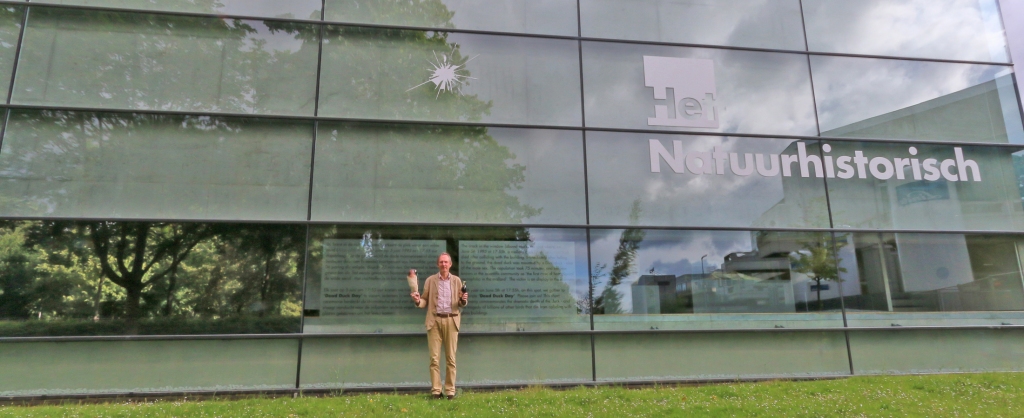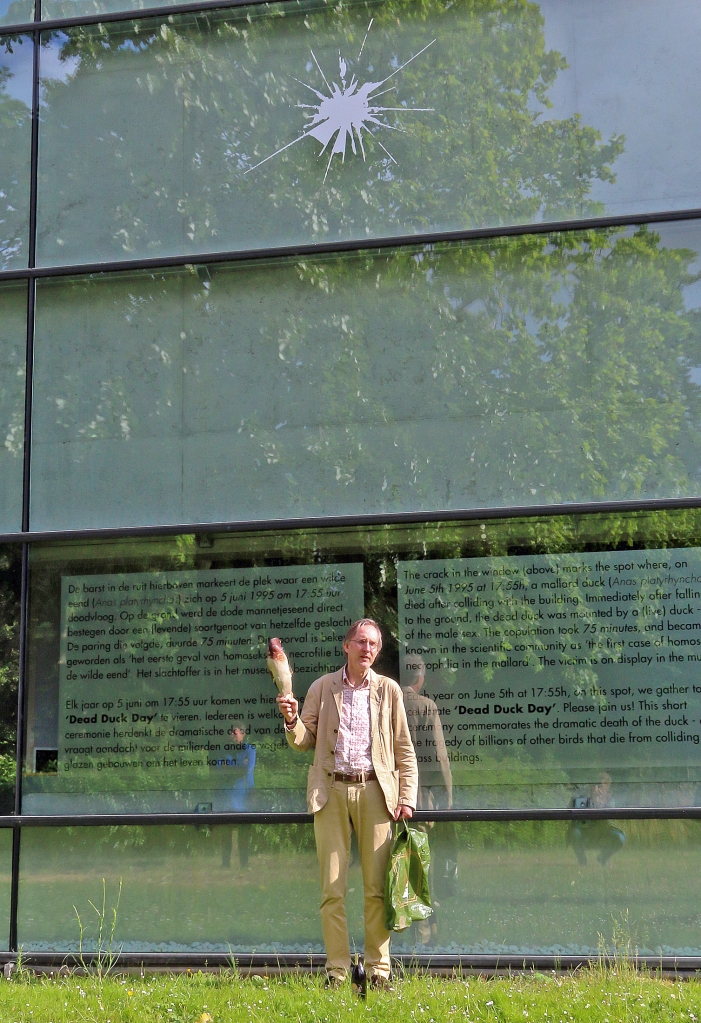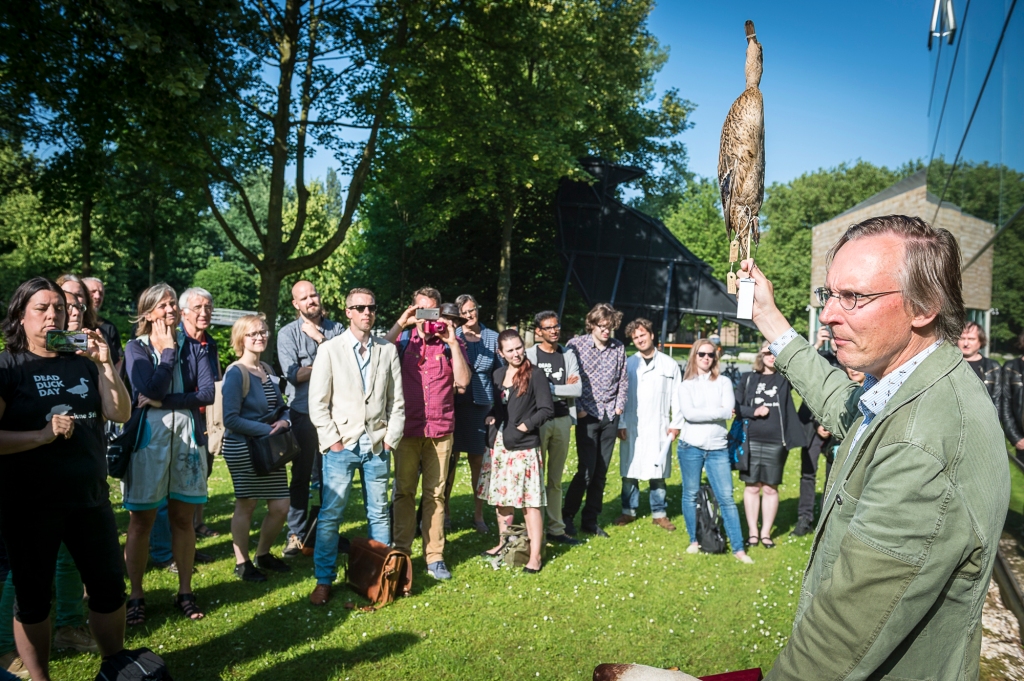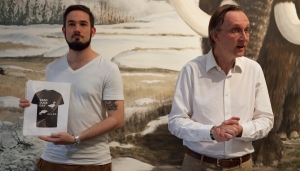Op zaterdag 29 september 2018 mocht ik in Rotterdam met een column de conferentie ‘Groen van de toekomst‘ aftrappen. Voordat ik begon, heb ik onderstaand filmpje laten zien:
Dit is de zogenaamde ‘leader’ van de televisieserie ‘Rotterdammers in het Groen‘ die RTV-Rijnmond vanaf 22 september 2018 wekelijks uitzendt. Mijn rol is die van presentator, hoewel ‘presenteren’ een groot woord is – ik fiets door de stad, praat met ‘Rotterdammers in het Groen’ en af en toe roep ik wat. Wat ik zeg in dit filmpje, klopt. Ik ben eigenlijk altijd met dieren bezig, met dode dieren in het Natuurhistorisch Museum waar ik werk, of als ik buiten ben, met het rijke dierenleven in het Rotterdamse groen. Mensen in het groen heb ik eigenlijk altijd als hinderlijk ervaren. Ze jagen de vogels weg, vertrappen de planten, zagen bomen om, maaien het gras. En nu wilde Rijnmond juist mij mensen in de stadsnatuur laten bestuderen. Ze zochten een antwoord op de vraag ‘Wat doen ze er, waar en waarom?’.
Uiteindelijk heb ik het met veel plezier gedaan, vijf afleveringen – ‘Het stadspark’, ‘De singel’, ‘De stadstuin’, ‘De productietuin’ en ‘De volkstuin’. Kilometers gemaakt op een vouwfiets, van IJsselmonde tot in Overschie en van Schoonoord tot de Spoortuin. Ik moet toegeven dat mijn blik regelmatig afdwaalde af naar een tikkende specht of een jagende sperwer, maar toch kreeg ik de smaak te pakken, op mijn zoektocht naar mensen in parken en tuinen, op daken en langs singels.
Ik ben op groene plekken geweest die zelfs ik nog niet kende. Hippe dakakkers, verborgen stadstuintjes, braakliggende terreinen, volkstuinen, zelfs een verlaten treinspoor dat als onderdeel van ‘de Groene Connectie’ nu door een heuse stadsjungle voert. Met overal enthousiaste mensen die er van genieten en er letterlijk zelf wat van maken.
Ik heb ontdekt hoe Rotterdammers parken, tuinen en singels op verschillende manieren omarmen als een natuurlijk verlengstuk van hun leefgebied. Stadsnatuur is echt onmisbaar, voor iedereen!
Dat besef hebben we nog niet zo lang. Ik beweeg mij al een halve eeuw door het Rotterdamse groen. Heb de eekhoorns van het Kralingse Bos nog gekend. Heb de eerste Nijlgans zien komen, en ken de stad nog zonder aalscholvers en halsbandparkieten. Met mijn verrekijker had ik er tot een jaar of tien geleden bijna het rijk alleen. Hoe komt het dat de Rotterdammer openbaar groen terecht steeds meer als zijn natuurlijke habitat beschouwt en benut?
Dat heeft te maken met het besef dat natuur goed voor je is – je voelt je er fijn. Er is inmiddels een dikke stapel wetenschappelijk onderzoek die bewijst dat stadsmensen die een flinke portie buurtnatuur tot zich kunnen nemen, geestelijk en lichamelijk gezonder zijn dan mensen die dat moeten missen. Ziektecijfers zijn aanmerkelijk lager in groenere woongebieden. Lagere niveaus van depressie, angst en stress blijken geassocieerd met het aantal vogels dat mensen in hun omgeving kunnen zien. Het horen van vogelzang doet daar nog een schepje bovenop: het is rustgevender dan het geluid van kabbelend water en het zachtjes tikken van regen. Zelfs het voeren van vogels levert een heilzame klik tussen mens en natuur. Patiënten die in het ziekenhuis uitkijken op groen, genezen sneller dan zieken die uitzicht hebben op een blinde muur.
Na vijf weken filmen in de Rotterdamse stadsnatuur heb ik gezien hoe bestaande parken en andere groenvoorzieningen steeds intensiever gebruikt worden. Ik heb buurtbewoners letterlijk stadsnatuur zien maken, de BBQ-rookwolken boven het Vroesenpark zien opstijgen, en ben door een vrolijk dansend festivalpubliek op de schouders genomen. Ook heb ik kritische geluiden gehoord over wat wel en niet kan in een park. Waar ligt die grens?
De draagkracht van een park verschilt natuurlijk wezenlijk van die van een asfaltvlakte. De grens die gesteld moet worden, moet mensen de kans geven van het stadsgroen te genieten zonder uit het oog te verliezen dat juist het planten- en dierenleven de aantrekkelijkheid van parken bepaalt. Ik ken de veerkracht van de stadsnatuur en ben er van overtuigd dat ook uitzinnige festivalgangers liefhebbers zijn van het Rotterdamse groen. De grens van wat wel en niet kan, is een delicaat evenwicht tussen mens en natuur.
Natuurbesef is hierbij van groot belang, en biodiversiteit het toverwoord. Het toepassen van ecologische kennis in de stedelijke omgeving komt niet alleen plant en dier maar juist ook stadsmensen ten goede. Daar zou bij het groenbeheer vol op ingezet moeten worden. Benut braakliggende terreinen, maak groene verbindingen (ook met het buitengebied), maai bewust en met mate, geef insecten een kans, betrek burgers bij aanleg en onderhoud, en garandeer dat parken niet opgeofferd worden voor woningbouw of wegenaanleg.
Met het gestaag groeiende aantal mensen dat in een stedelijke omgeving leeft – nu al ruim 50 procent en in 2050 zeker 70 procent van de wereldbevolking – is het belang van stadsnatuur groter dan ooit.
Deze conferentie heet ‘Groen van de toekomst’. Ik zeg ‘Groen heeft de toekomst’.
.








 Sunday June 5th, 2016 is the 21th edition of
Sunday June 5th, 2016 is the 21th edition of 

 On June 5th, 2015, the 20th
On June 5th, 2015, the 20th  illions of other birds that have died in collision with glas building, Kees Moeliker payed a tribute to the recently deceased
illions of other birds that have died in collision with glas building, Kees Moeliker payed a tribute to the recently deceased 

 Necrophilia is a behaviour which reveals its unlimited curiosities almost regularly. Kees discovered a curiosity 20 years back. About a decade later as we were studying necrophiles from around the world, we discovered that it could be classified in 10 different types, starting from most innocuous “Role players” to the most dangerous “Exclusive necrophiles”. Gradually as we studied other paraphilias, it dawned upon us, that the very same classification could be extended to zoophiles too. Both studies were published in reputed journals. Were we on to something big? Do all paraphilic behaviors show same 10 gradations? Does a so-called “law of paraphilic equivalence” exist, which might state something to the effect that “all paraphilias are similar to one another, in as far as all of them exist on a continuum of increasing severity ranging from the most innocuous to the most dangerous?” Curiously as we studied more and more paraphilias with this objective in mind, we discovered that the law indeed was true. Most recently we have proved this in relation to even non-contact paraphilias, eg exhibitionism. For quite some time now, we had been thinking to bring together on one platform the necro-academics [my own term for scientists exploring this behavior] from around the world and publish their findings together in one book. Three academicians from around the world, including me got together a year back and were able to do exactly that. We got about 40 necro-academics from around the world and asked them to contribute their own experiences in the field of necrophilia in an anthology called ‘Understanding Necrophilia: A Global Multidisciplinary Approach’. Kees, to our honor, agreed and wrote an excellent chapter on necrophilia in the animal kingdom. I hope one day he discovers the 10 different kinds of necrophilia in the animal kingdom too, just as we have discovered it in humans. Necrophilia, thus, not only is a curious behavior, it is leading us on to new vistas in the study of paraphilic behavior.
Necrophilia is a behaviour which reveals its unlimited curiosities almost regularly. Kees discovered a curiosity 20 years back. About a decade later as we were studying necrophiles from around the world, we discovered that it could be classified in 10 different types, starting from most innocuous “Role players” to the most dangerous “Exclusive necrophiles”. Gradually as we studied other paraphilias, it dawned upon us, that the very same classification could be extended to zoophiles too. Both studies were published in reputed journals. Were we on to something big? Do all paraphilic behaviors show same 10 gradations? Does a so-called “law of paraphilic equivalence” exist, which might state something to the effect that “all paraphilias are similar to one another, in as far as all of them exist on a continuum of increasing severity ranging from the most innocuous to the most dangerous?” Curiously as we studied more and more paraphilias with this objective in mind, we discovered that the law indeed was true. Most recently we have proved this in relation to even non-contact paraphilias, eg exhibitionism. For quite some time now, we had been thinking to bring together on one platform the necro-academics [my own term for scientists exploring this behavior] from around the world and publish their findings together in one book. Three academicians from around the world, including me got together a year back and were able to do exactly that. We got about 40 necro-academics from around the world and asked them to contribute their own experiences in the field of necrophilia in an anthology called ‘Understanding Necrophilia: A Global Multidisciplinary Approach’. Kees, to our honor, agreed and wrote an excellent chapter on necrophilia in the animal kingdom. I hope one day he discovers the 10 different kinds of necrophilia in the animal kingdom too, just as we have discovered it in humans. Necrophilia, thus, not only is a curious behavior, it is leading us on to new vistas in the study of paraphilic behavior.






You must be logged in to post a comment.